|
Quality Over Quantity
by Bob Brooke
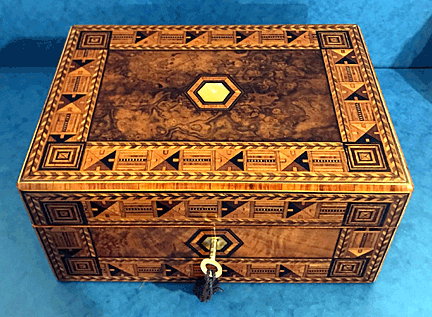 An
old sage once said, ďOne object is a possession. Two or more is a
collection.Ē Collecting, especially collecting antiques, can be
addictive. The love of antiques and collectibles can dominate a
collectorís life. Once a collector begins buying, he or she tends to
keep going and going and going. What results is a massive collection of
all sorts of antiques. Most people canít resist the desire to keep
buying and buying. An
old sage once said, ďOne object is a possession. Two or more is a
collection.Ē Collecting, especially collecting antiques, can be
addictive. The love of antiques and collectibles can dominate a
collectorís life. Once a collector begins buying, he or she tends to
keep going and going and going. What results is a massive collection of
all sorts of antiques. Most people canít resist the desire to keep
buying and buying.
Itís the buying and admiring of unique and beautiful things from the
past that gives the collector great pleasure. But while buying lots of
objects satisfies this desire, obtaining a few choice pieces is far
better than lots of lesser ones.
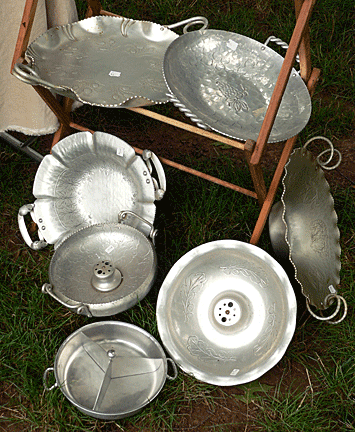 In
the beginning, I purchased just about every item that I liked. This was
because I didnít know enough about what I was collecting and bought
indiscriminately. About the only thing that limited me was the lack of
enough money to continue. But in this instance, I bought less expensive
pieces which meant lesser quality ones. Unfortunately, lesser quality
items donít usually appreciate in value, at least not as much as higher
quality ones. In
the beginning, I purchased just about every item that I liked. This was
because I didnít know enough about what I was collecting and bought
indiscriminately. About the only thing that limited me was the lack of
enough money to continue. But in this instance, I bought less expensive
pieces which meant lesser quality ones. Unfortunately, lesser quality
items donít usually appreciate in value, at least not as much as higher
quality ones.
I sought out quantity, not quality when I should have been doing the
opposite. But I didnít realize that until a couple of years had passed.
By then, I found myself buried in antiques. I had collected in so many
areas, and purchased so many pieces, that there wasn't room to display
anything properly. By that time, I discovered that I was unable to
complete any of my collections. I couldn't possibly gather a "complete"
collection of anything, Because I was collecting so many different
things.
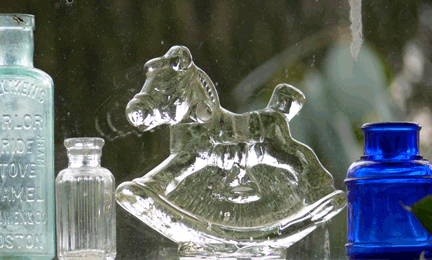 Since
I learned from my mistakes, Iíve turned the situation around. Iíve sold
many of the inferior examples and replaced them with better pieces. Due
to a lack of display and storage space, Iíve had to narrow my collecting
interests. It just wasn't possible for me to collect everything I liked,
so I picked my favorites and stuck with them. As a result, I started
developing small, higher quality collections. Since
I learned from my mistakes, Iíve turned the situation around. Iíve sold
many of the inferior examples and replaced them with better pieces. Due
to a lack of display and storage space, Iíve had to narrow my collecting
interests. It just wasn't possible for me to collect everything I liked,
so I picked my favorites and stuck with them. As a result, I started
developing small, higher quality collections.
I discovered several advantages to going the higher quality route. I
soon realized that I was doing much better from an investment standpoint
since choice pieces appreciate in value more quickly than more common
ones. As I began focusing my available funds on a few, more expensive
items, the value of my collections rose faster than ever.
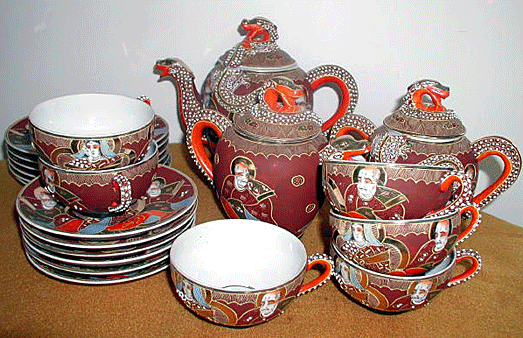
As I mentioned above, display and storage space quickly became a problem
for me. My collection of Satsuma-style ware, the largest I have, now
approaches several hundred objects of varying sizes. This has forced me
to display only a portion of the collection at a time, storing the
remainder in boxes.
 People
who collect clocks, for example, quickly realize that having too many
not only produces display problems but takes time winding and
maintaining them. Purchasing several quality pieces, rather than
purchasing a number of them, helps alleviate both problems. People
who collect clocks, for example, quickly realize that having too many
not only produces display problems but takes time winding and
maintaining them. Purchasing several quality pieces, rather than
purchasing a number of them, helps alleviate both problems.
And when it comes time to sell items from a collection, quality antiques
have the advantage. Buyers looking to buy more common pieces have a
number of opportunities, but those purchasing more expensive items will
be looking in perhaps one or two places. So if I should ever want to
sell one of my better pieces, I shouldnít have a problem finding buyers.
However, I didnít waste my money on the pieces I have acquired. I can
always sell off the more common piecesóthough it may take some timeóand
use the funds gained from them to purchase better ones, thus upgrading
my collections. To do this, I periodically take inventory of what I have
and set aside those pieces I want to dispose of.
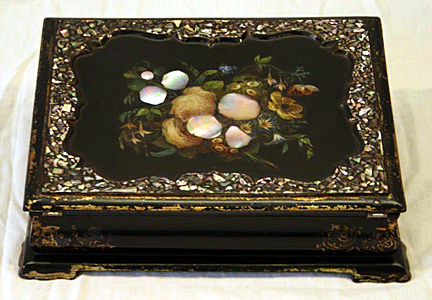 One
thing I learned a long time ago is that itís very important to get rid
of pieces that need repair or are in a state of deterioration. Once a
piece gets to a point that itís beyond repair, itís value will plummet.
Itís better to sell it and use the money to buy a better one. This
happened with a papier machť writing slope that was part of my
collection of writing boxes. At the time, my house was rather damp and
this began affecting it. So rather than try to stop the deterioration, I
sold it for a little over what I paid for it. While I didnít make a huge
profit, I didnít lose any money, either. One
thing I learned a long time ago is that itís very important to get rid
of pieces that need repair or are in a state of deterioration. Once a
piece gets to a point that itís beyond repair, itís value will plummet.
Itís better to sell it and use the money to buy a better one. This
happened with a papier machť writing slope that was part of my
collection of writing boxes. At the time, my house was rather damp and
this began affecting it. So rather than try to stop the deterioration, I
sold it for a little over what I paid for it. While I didnít make a huge
profit, I didnít lose any money, either.
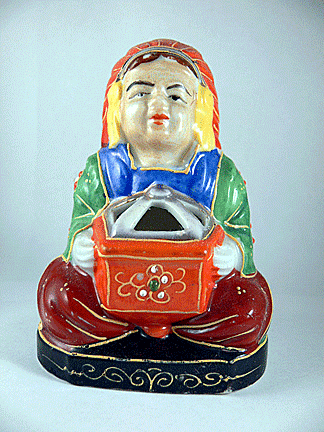 Another
problem occurs when a collector buys too many expensive pieces in the
beginning, thinking that he or she can always purchase the less
expensive ones later. While I didnít do this with my Satsuma-style ware,
I discovered that all the pieces began to skyrocket in price, whether
they were of poorer or better quality. So common pieces I had purchased
for a few dollars were three or four times that now. Another
problem occurs when a collector buys too many expensive pieces in the
beginning, thinking that he or she can always purchase the less
expensive ones later. While I didnít do this with my Satsuma-style ware,
I discovered that all the pieces began to skyrocket in price, whether
they were of poorer or better quality. So common pieces I had purchased
for a few dollars were three or four times that now.
Donít get me wrong. Itís a good idea to purchase a few common pieces in
the beginning. This allows a novice collector to learn about a new
collecting area while keeping financial risk to a minimum. Aiming for
quality pieces in the beginning can lead to expensive mistakes. Itís
important to test the waters before taking a major plunge.
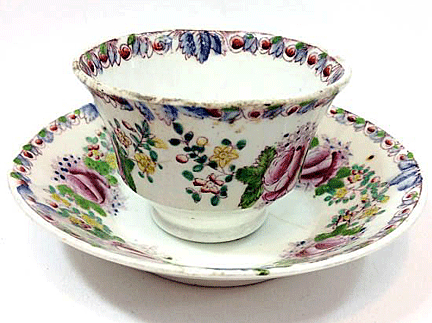 Finally,
itís very important to be selective. Pay attention to condition. I have
a small collection of tea bowlsóhandleless tea cups and saucers from the
19th century. The prices of those in perfect condition are
stratospheric, way out of my budget range. So I look for ones that may
have a slight crack or some other imperfection. While I donít find them
very often, I have managed to find enough to build a nice little
collection. Finally,
itís very important to be selective. Pay attention to condition. I have
a small collection of tea bowlsóhandleless tea cups and saucers from the
19th century. The prices of those in perfect condition are
stratospheric, way out of my budget range. So I look for ones that may
have a slight crack or some other imperfection. While I donít find them
very often, I have managed to find enough to build a nice little
collection.
<
Back to Antiques Extra! Archives
Next Article >
|
